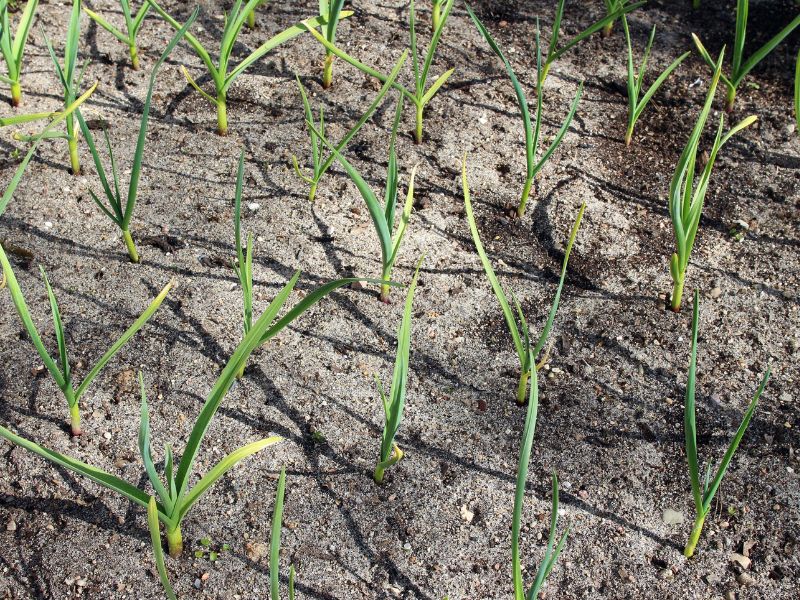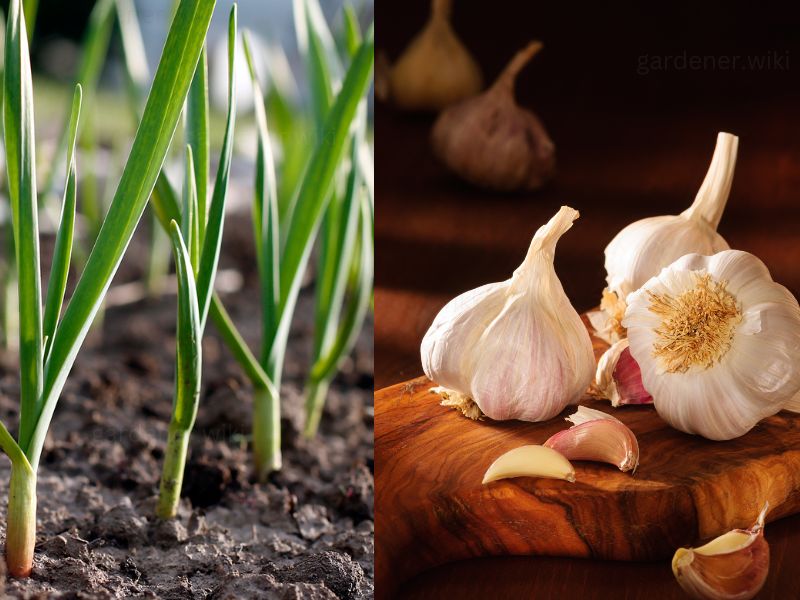Welcome to Gardener.Wiki – Our first post will be about one of our most beloved vegetables: Garlic! We love to use garlic in our insanely tasty tomato salads. Let’s dig deep into it!
As an experienced gardener, I can tell you that growing garlic can be both rewarding and enjoyable. With attention to detail and a few extra steps, you can grow even better garlic. Here’s a comprehensive guide (comprehensive enough to get started on your garlic journey) on how to grow garlic with some added tips from my personal experience:
Choose the right variety
Do some research on the garlic varieties that thrive in your local climate. Softneck varieties are better suited for milder climates, while hardneck varieties perform better in colder regions. Personally, I’ve had great success with ‘Music’ (a hardneck variety, raw, it’s fiery and spicy, but cooked, it becomes sweet and flavorful.) and ‘Inchelium Red’ (a softneck variety, initially, it may have a strong flavor, but after being stored, the heat subsides.). We have grown many other varieties. You will be amazed at what’s out there. These varieties will blow away the common store garlic you are used to.
Planting time
Plant garlic in the fall, about 4-6 weeks before the ground freezes. This allows the garlic to establish roots before winter. In warmer climates, you can plant garlic in late winter or early spring.
Soil preparation
Garlic prefers well-draining, fertile soil with a pH between 6.0 and 7.0. Loosen the soil to a depth of at least 12 inches and work in a generous amount of compost or well-rotted manure. I’ve found that adding some organic matter, like worm castings, can give the plants a nice boost.
Planting
Separate the garlic bulbs into individual cloves, keeping the papery skin intact. Plant the cloves 3-4 inches deep and 6-8 inches apart, with the pointed end facing upwards. Rows should be spaced about 12-18 inches apart. In my experience, planting the largest cloves often results in bigger bulbs.
Mulching
Apply a layer of mulch (e.g., straw, shredded leaves, or grass clippings) to help retain moisture, suppress weeds, and provide insulation during winter. I’ve found that using straw mulch can prevent the soil from becoming too compacted and helps keep the garlic clean.
Watering
Keep the soil consistently moist but not waterlogged. Overwatering can lead to rot, while under-watering can result in small bulbs. I use a drip irrigation system to ensure consistent watering without over-saturating the soil.
Fertilizing
Apply a balanced organic fertilizer in early spring and then again when the garlic starts to produce its green leaves. I often use a liquid seaweed or fish emulsion fertilizer, as they provide essential nutrients for bulb development.
Weed control
Regularly remove weeds to prevent competition for nutrients and water. I use a hand hoe or cultivator to carefully remove weeds without disturbing the garlic roots.
Pests and diseases
Garlic is relatively pest-resistant, but some common issues include onion thrips, nematodes, white rot, and bulb mites. Monitor your plants for signs of infestation and use organic or chemical controls as needed. I use neem oil as a preventative measure against pests and fungal diseases.
Harvesting
Garlic is typically ready to harvest when the lower leaves turn brown, and the top leaves are still green (around mid-summer for most varieties). Carefully loosen the soil around the bulbs with a garden fork before pulling them up. Harvesting early in the morning, when temperatures are cooler, can help preserve the quality of the bulbs.
Curing
Allow the harvested bulbs to cure in a well-ventilated area, out of direct sunlight, for 2-3 weeks. I like to hang my garlic in small bundles or spread them out on a drying rack to ensure proper air circulation.
Storing
Once cured, store your garlic bulbs in a cool, dry place with good air circulation. Softneck varieties can be braided and hung, while hardneck varieties can be stored in mesh bags or open containers. Proper storage can extend the shelf life of your garlic and maintain its quality for several months.
By following these steps and incorporating the additional tips from my personal experience, you’ll be well on your way to growing and enjoying your own high-quality, homegrown
Now let’s go over your region and the effects on growing garlic:
The United States:
The success of garlic cultivation is influenced by regional climate and temperature. Here’s an overview of how to start garlic in different regions, and the effects of temperature on its growth:
- Cool to cold climates (e.g., USDA Zones 3-6): In these regions, hardneck garlic varieties are a better choice due to their cold tolerance. Plant garlic in the fall, around 4-6 weeks before the first hard frost. This allows the garlic to establish roots before winter sets in. Garlic requires a period of vernalization (cold exposure) to stimulate bulb formation, which these climates naturally provide. To protect the plants from harsh winter temperatures, apply a thick layer of mulch (e.g., straw or shredded leaves) over the planting area.
- Mild climates (e.g., USDA Zones 7-9): In milder climates, softneck garlic varieties are more suitable. Planting can be done in late fall or early winter, as there’s no need to worry about extreme cold damaging the plants. In these areas, garlic may not experience sufficient vernalization, which could result in smaller bulbs or a failure to form bulbs altogether. To overcome this, you can pre-chill the garlic cloves in the refrigerator for 4-6 weeks before planting to simulate cold exposure.
- Warm to hot climates (e.g., USDA Zones 10-11): Growing garlic in hot climates can be challenging due to the lack of vernalization and the risk of heat stress. Choose heat-tolerant or early-maturing softneck varieties. Plant in late winter or early spring, when temperatures are cooler. Pre-chill the cloves in the refrigerator, as mentioned above, to encourage bulb formation. Provide some shade during the hottest part of the day to reduce heat stress and ensure that the soil remains consistently moist but not waterlogged.
Effects of temperature on garlic growth:
- Optimal temperature range: Garlic grows best at temperatures between 55°F (13°C) and 75°F (24°C). Within this range, garlic can develop a robust root system and produce healthy foliage, which supports bulb formation.
- Cold temperatures: Exposure to cold is necessary for garlic to form bulbs, particularly in hardneck varieties. However, extreme cold can damage or kill garlic plants, especially if they’re not well-established before winter. Applying mulch can help insulate the plants and protect them from freezing temperatures.
- High temperatures: Prolonged exposure to high temperatures can stress garlic plants, potentially reducing bulb size and quality. Heat stress can also cause the plants to bolt (produce a flower stalk), which may further reduce bulb development. In hot climates, providing shade and maintaining adequate soil moisture can help mitigate the effects of high temperatures.
In conclusion, it is crucial to take into account local climate and temperature conditions while beginning garlic in different places. To maximize growth and bulb development, it is important to select appropriate cultivars, alter planting schedules, and give proper care.

Europe
Garlic growing conditions can be affected by Europe’s varying climates. Learn how to get your garlic off to a good start no matter where in Europe you live by using our handy temperature chart:
- Northern Europe (e.g., Scandinavia, the Baltic States, UK, and Ireland): These regions generally have cool to cold climates. Hardneck garlic varieties are better suited here due to their cold tolerance. Plant garlic in the fall, ideally between September and October. These areas’ natural vernalization (cold exposure) will stimulate bulb formation. Protect the plants from harsh winter temperatures by applying a thick layer of mulch, such as straw or shredded leaves, over the planting area.
- Central Europe (e.g., Germany, Poland, Switzerland, Austria, and the Czech Republic): Central European climates can vary from cool to mild. Both hardneck and softneck garlic varieties can be grown in this region. Plant garlic in the fall, typically between October and November. The colder parts of Central Europe will provide sufficient vernalization for bulb formation, while milder areas may require pre-chilling of cloves before planting.
- Western Europe (e.g., France, Belgium, and the Netherlands): Western Europe generally experiences mild to cool climates. Softneck garlic varieties are well-suited for these regions, although hardneck varieties can also be grown. Plant garlic in the fall, between October and November. In milder areas, pre-chilling the cloves might be necessary to ensure proper bulb formation.
- Southern Europe (e.g., Spain, Italy, Greece, and Portugal): Southern Europe has a Mediterranean climate with warm to hot summers and mild winters. Softneck garlic varieties are more appropriate for this region due to their heat tolerance. Plant garlic in late fall or early winter, around November to December, when temperatures are cooler. Pre-chill the cloves in the refrigerator for 4-6 weeks before planting to simulate cold exposure and encourage bulb formation. Provide some shade during the hottest part of the day to reduce heat stress, and ensure that the soil remains consistently moist but not waterlogged.
Effects of temperature on garlic growth in Europe:
- Optimal temperature range: Garlic grows best at temperatures between 13°C (55°F) and 24°C (75°F). Within this range, garlic can develop a robust root system and produce healthy foliage, which supports bulb formation.
- Cold temperatures: Exposure to cold is necessary for garlic to form bulbs, particularly in hardneck varieties. However, extreme cold can damage or kill garlic plants, especially if they’re not well-established before winter. Applying mulch can help insulate the plants and protect them from freezing temperatures.
- High temperatures: Prolonged exposure to high temperatures, more common in Southern Europe, can stress garlic plants and potentially reduce bulb size and quality. Heat stress can also cause the plants to bolt (produce a flower stalk), which may further reduce bulb development. In hot climates, providing shade and maintaining adequate soil moisture can help mitigate the effects of high temperatures.
In summary, when starting garlic in different regions of Europe, consider the local climate and temperature conditions. Choose appropriate varieties, adjust planting times, and provide suitable care to ensure the best possible growth and bulb formation.
To Wrap it up
Choosing the proper variety, preparing the soil, planting, mulching, watering, fertilizing, and dealing with pests and illnesses are all important steps in growing outstanding garlic. If you want your homegrown garlic to taste its best, it’s important to harvest it, cure it, and store it properly. You can grow excellent garlic in your yard if you follow these instructions and consider my advice. Don’t forget the importance of being patient and paying close attention to detail; eventually, you’ll figure out what works best in your garden. Have fun in the garden, and reward yourself with the flavor of garlic you grew from seed.
© 2023 by gardener.wiki. All rights reserved. No part of this document may be reproduced or transmitted in any form or by any means, electronic, mechanical, photocopying, recording, or otherwise, without prior written permission of gardener.wiki.

